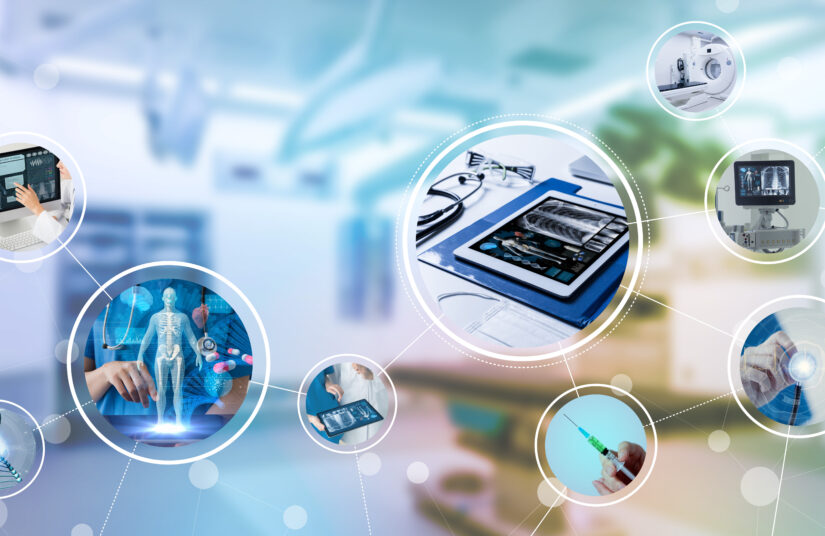What is interoperability in healthcare?
A recent report from the US highlighted the importance of interoperability in managing the coronavirus pandemic. Whilst it is widely accepted that interoperability is key to the successful delivery of healthcare, it is by no means a challenge just for the healthcare industry. The challenge however is magnified by the sheer volume of siloed systems in existence across NHS trusts. Here we look at what interoperability means, why it’s important, and how it could all be a lot simpler.

Defining interoperability in healthcare
A Google search reveals over 14 million results for ‘healthcare interoperability’ and there may well be millions of definitions. The industry group working towards developing open standards in the UK, INTEROPen, describes interoperability as “the ability to exchange information between systems and for the receiving system to be able to process and reason on that data.”
At its very basic level, interoperability is about getting systems to talk to one another. Disparate software exchanging data between a range of sources including hospitals, GP’s, pharmacies, laboratories and clinics. The intent of interoperability is to have a holistic view of patient information despite the variances in the technologies used across these sources. This enables clinicians to make better decisions using the most up-to-date information, resulting in safer and faster treatment that improves the overall patient experience.
Levels of interoperability in healthcare – it’s all about data
Interoperability is complicated by the technology used to build systems and specifically, the data within them that needs to be exchanged. HIMSS describes three levels of interoperability:
- Foundational Interoperability – data is ready to use. Connected systems do not need to interpret it.
- Structural Interoperability – data is interpreted into the required format of receiving systems. Patient records are an example of structural interoperability.
- Semantic Interoperability – systems share information seamlessly. Underlying data is developed using standard definitions and codification.
Interoperability in the NHS – the challenge of legacy systems
Typically, the NHS and organisations such as INTEROPen focus on level 3 of interoperability (semantic interoperability) – the need for consistent standards across providers of healthcare systems. There is also a lot of encouragement for new systems to be built with interoperability included.
However, the major challenge facing the NHS is the plethora of existing systems. A typical trust has upwards of 300 IT systems, developed in different technologies, often working in silos. Even a single department such as cardiology could have multiple systems that have been adopted over time.
The introduction of integration engines has started to chip away at the interoperability challenge, but there is still a long way to go. The Integration Engine takes messages from different systems, modifies them to be understood by other systems, before distributing the messages to where they’re needed. The Integration Engine doesn’t display patient data in a single view.
That’s where technology such as IMX (which is supplier agnostic) is a sensible way of bringing together disparate systems and creating a holistic view of patient information in a single place, as it is built on open technology and standards, taking away interoperability challenges with source systems.
Why is interoperability important in healthcare?
The primary benefit of any digital initiative in the NHS is to improve patient outcomes and the quality of care. Interoperability not only achieves this but also helps reduce cost too.
Giving clinicians complete and consistent visibility of patient information enables them to make better-informed decisions, faster. And patient experience improves as they no longer have to repeat the same information to different healthcare professionals involved in their care. With time-saving comes greater efficiency.
Interoperability across the healthcare spectrum also promotes continuity leading to safer transitions of care. Various studies show that patients get better quicker at home rather than in a hospital. Reducing time spent in hospital is a core objective of the NHS and interoperability is key to its success – consider home visits by nurses with access to patient history, integrated apps for remote monitoring, video communication and more.
Here’s an interesting study from a hospital in Boston (USA) which demonstrates that care at home not only improves outcomes but also reduces costs by 40%.
Simplifying interoperability in healthcare
To provide the holistic patient view that true interoperability dictates, we must join up information across different places, neighbourhoods and longitudinal care records. If one hospital has 300 systems, a typical patient who has moved across the UK in their lifetime, could have a piece of their data reside in thousands of systems. Add to that social care, mental health and social prescribing, and the complexity soon adds up.
Here’s where an innovative platform such as IMX really comes into its own. The IMX Clinical Record eliminates a lot of the complexity of integrating disparate systems by pulling information directly from source systems (or via a data feed), visualising what’s important, and sharing that with the people who need it, across organisations and across geographies.
See IMX in action.
Interested in medications interoperability? Join our experts Keli Shipley and Malcolm Newbury at the INTEROPen Medications Interoperability Hackathon online on 14th/15th July.
Find out more
For help assessing the interoperability level of your organisation, and how you could save money, talk to an expert today on 01392 363888 or email [email protected].

